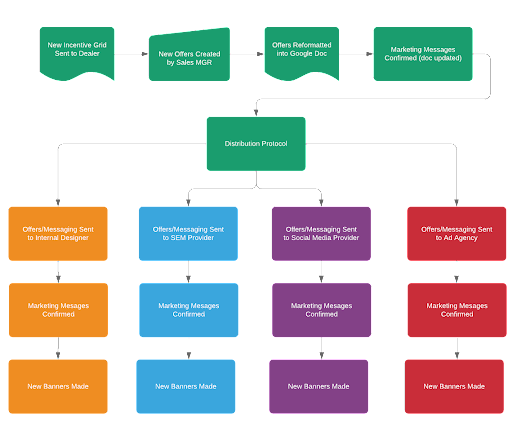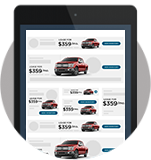Written by Matthew Strunk
Marketing efforts that are reliably profitable for your dealership can feel elusive and challenging to make, but there’s hope! At our company, AutoSigma, we create software that helps dealerships and their agency partners create, update, and automate their marketing offers and messaging. Working with our clients, I’ve learned that there are several proven steps you can make to improve your dealership’s marketing, whether you have a high performing marketing team or you’re refining your existing strategy.
Generally, a lot of dealers that we work with are growth minded, which is great, but in the effort to maximize revenue, they can get carried away with expenditures in the marketing department. On the other extreme, many other dealers can be very reserved and only focus on minimizing operating expenses while losing a lot of opportunity because they’re just not allowing their marketing efforts any chance to perform. But it’s absolutely possible to drive additional revenue from great marketing while cutting out unnecessary costs, resulting in a leaner and more efficient marketing plan.
The Transformational Triangle
So how do you strike the right balance in your marketing efforts? When evaluating our most profitable dealerships we’ve found that there are typically three areas they all share in common for improved process development towards more lucrative and stable growth. These areas are Efficiency, Effectiveness, and Experience.

Let’s dive into each of these areas in more detail.
Efficiency
For many dealerships, there’s usually a loose understanding of their marketing process with a specific focus on being aware of the budget and incoming customer incentives. But they don’t often have things like internal workflow diagrams or process charts from partner marketing firms in order to stay aware of how both internal and external marketing efforts directly affect your business.
Keeping records of how every marketing task fits into a department workflow helps you understand each part of the process and which parts are crucial, missing, or redundant. The very OEMs that dealerships represent spend a ton of money on researching and applying process methodologies to become more efficient. It doesn’t have to apply to just manufacturing. This approach also applies to your entire dealership, from the office to sales to marketing. Let’s use an example diagram to better visualize what we’re talking about:

While the above process can be functional, there are plenty of operational redundancies at play and important questions that could help reduce costs substantially without losing quality work. For instance, here are just a few observations and questions that could optimize this marketing workflow diagram:
- Why are there separate creative departments across four different marketing channels? The social media content could be repurposed from assets created by the internal designer, saving time and money from executing different strategies.
- Are the social media designs related to the website designs or the work the agency is doing?
- Is there an ad agency that also handles social media and/or SEM analytics to reduce how many external parties are necessary for my dealership’s marketing process?
With that overview out of the way, it is time for you to begin learning more about your own marketing workflow. Here’s a good place to start:
- Go to something like lucidchart.com or similar and create your own workflow diagram based on your unique process.
- Use the swimlanes to categorize different sections of your workflow. This could be by service or by phase.
- You can color code each step based on the role of the individual responsible for it.
- Don’t overthink this. Just get your first version out and then refine as you move forward. You can review this each month with your other closing procedures.
- Each symbol stands for a different type of step. It could be a document, a process, a decision, or a termination point. Those will get you pretty far.
- Understand that each “process” step kicks off another process, which would be documented in a separate SOP (standard operating procedure).
- Each process can have its own workflow diagram which helps further break down the process (recommended).
- Your SOPs plus workflow diagrams will be combined to create your marketing playbook.
Effectiveness
A lot of dealerships know they need efficient marketing, but they don’t necessarily know how to determine what type of marketing is effective. There’s the old marketing adage: 50% of this is working, but which 50%? Now, I could write an entire series related to marketing attribution, but in this article we’re going to assume you have a process for determining that. If you don’t, you need to start there, and there are a lot of great articles out there to get you started.
Assuming you have that down, here are some things you can do in order to get a handle on what parts of your marketing process are most effective. We’ve included some of the steps and exercises we suggest clients practice:
Vendor & Source/Channel Audit Exercises
- Write down all the vendors involved in your marketing flowchart that you made earlier. If you haven’t done this yet, go do it.
- Go to your finance department and have them provide you with a list of all marketing expenses by vendor.
- Cross reference this list with the above list of vendors to ensure full coverage.
- Go to Google analytics and write down all of the sources/channels of traffic currently and write down the responsible party for each source/channel.
- Now write out each vendor and media channel along with the associated expense.
- Go line-by-line and determine the value the vendor and/or channel is providing expressed in a monetary format (for example, if something saves you time, then use your loaded hourly cost and/or the predicted value that you could create if you used that time elsewhere).
- There will be overlap by vendor and marketing channel, and that is okay! There is a chance that a channel provides value but the vendor is not, or vice versa.
Example Result:

Impact Assessment
The retail sector of automotive sales continues to grow digitally, and multi-channel marketing will keep growing too. Such growth brings the potential to provide improved ways to both help customers and extract more lifetime value (LTV). And by taking the time to more fully understand how different areas of your dealership’s marketing efforts are worth it or not, you can more thoroughly make changes that will impact your overall efficacy.
To get a better grasp on how your dealership’s marketing is effective in certain areas while not as much in others, consider the evaluative steps below:
- Take your list of vendors and channels and organize them based on the value provided to your dealership. This was done in the prior section, if you haven’t done that yet, do it.
- Label them according to effectiveness.
- Examples: A-F, or 1-6, or Platinum – Bronze. The naming convention isn’t important, but it will help you as you evaluate future options by determining what sort of value it brings.
- Any vendor or channel that doesn’t add any positive return on investment (ROI) should default to the lowest rank and likely get dismissed.
- Next, look at each vendor or channel and determine where the point of diminishing return is. This will also help you determine at which point the return of a “Grade A Channel” is lower than the starting value of a “Grade B channel.” All of this ultimately helps you determine your budgets and allocation.
- Remember, the first version of all these exercises is just that – the first version! Make sure you are always iterating and just take the next step.
Vendor/Channel Deep Dives
Now that you have this information, it is time to validate them. Is the vendor/channel underperforming because they aren’t valuable or is it not being executed properly? We don’t want to dismiss a channel because of a poor vendor. Here are some steps you can take to determine why a vendor/channel is underperforming.
- Work this list backward from those that are providing the least value to those who are providing the most.
- Some will be very quick and easy, others will take more time and that is okay, you won’t get this done in one sitting!
- Identify your audit you’ll perform. Example: If your Facebook ads aren’t performing then you need to perform an audit of your FB ad campaigns. If your website isn’t performing well then you need to perform a thorough website audit.
- Some examples of the things you will find include over-use of branded advertising campaigns), bidding on tier 1 keywords, and more!
Experience
Have you ever heard of or completed a Customer Journey Audit? What are the touchpoints that your business has with your customers? It’s up to you to determine what the entire customer journey experience is, and you can even break it down by department for segmented awareness of every stage. For our purposes, let’s just talk about the marketing side.
For example, it might be easy to think of your service department’s final customer touchpoint as paying the cashier. But in reality, the very last touchpoint for customers is driving their newly serviced vehicle off the lot. If your dealership is located on an especially busy street, it might be difficult to get on the main road, and even just that difficulty is a reality you should understand as the dealer. It doesn’t necessarily mean you can fix it, but you can potentially mitigate the issue or at least understand its relevance on the overall customer experience, and build solutions to provide support around those deficiencies.
An Example Structure For A Customer Journey Audit
- Measure the last touchpoint and work backwards (for marketing audits, use your conversion point)
- Document the flow similar to your workflow diagram from earlier (specifically, by conversion & channel)
- Run a Google Analytics report that shows you the funnel working backwards
- Go through the customer logs to find additional sources
- Go to each touchpoint that contributes toward your dealership’s online conversions (for getting onto a particular page – don’t filter by conversion!)
- Label the touchpoint and document your dealership’s customer experience with it – don’t overthink it!
- Don’t worry about optimization! Just document!
- Use the 80/20 rule
- Review, repeat, and refine

Common Customer Journey Issues To Watch For
- Inconsistent messaging (different information on different pages that create confusion)
- Poor landing page experience (this leads to higher costs-per-click and cost-per-acquisition)
- Confusing & conflicting calls to action
- Overwhelming information
- Technical issues
There’s no doubt that if you start focusing on your customer’s experience beginning with the first interaction, you will make massive strides towards improving their user experience and in turn your marketing performance.
The Time Has Come
While there is no such thing as a magic pill for marketing, I can assure you that if you start focusing on building a more efficient and effective marketing process centered around your customer’s journey, you will absolutely see a quantifiable shift in your bottom line. It doesn’t take long working through the above exercises to quickly start identifying areas of opportunity. So get started and take the next step.




